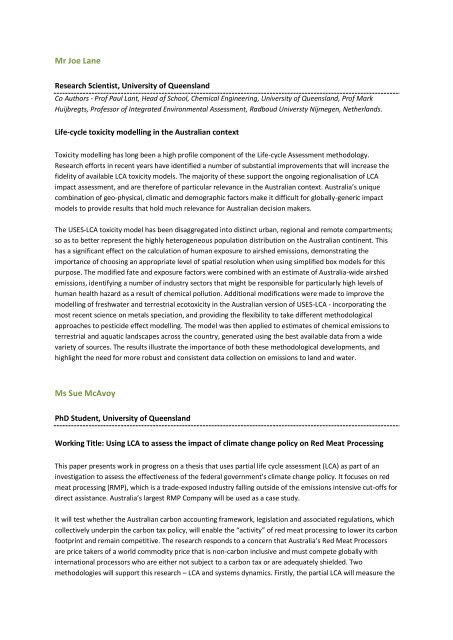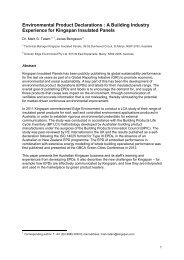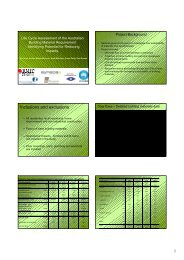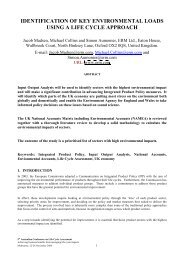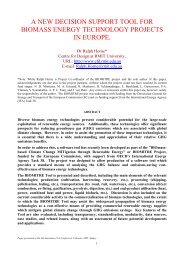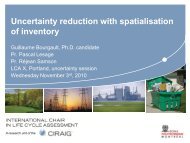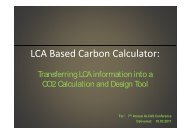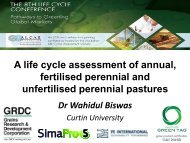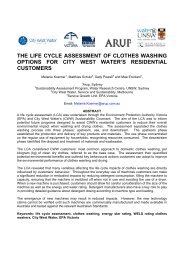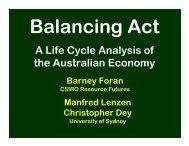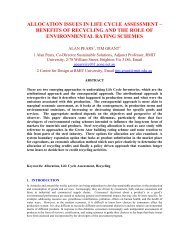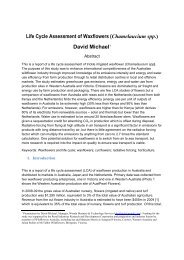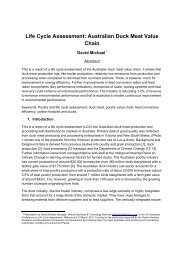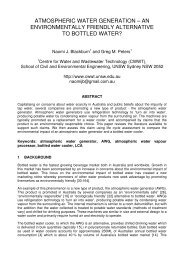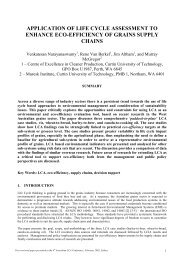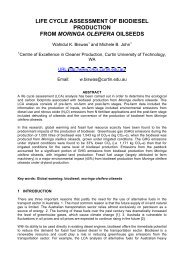Abstracts - ALCAS Conference - Australian Life Cycle Assessment ...
Abstracts - ALCAS Conference - Australian Life Cycle Assessment ...
Abstracts - ALCAS Conference - Australian Life Cycle Assessment ...
You also want an ePaper? Increase the reach of your titles
YUMPU automatically turns print PDFs into web optimized ePapers that Google loves.
Mr Joe Lane<br />
Research Scientist, University of Queensland<br />
Co Authors - Prof Paul Lant, Head of School, Chemical Engineering, University of Queensland, Prof Mark<br />
Huijbregts, Professor of Integrated Environmental <strong>Assessment</strong>, Radboud Universty Nijmegen, Netherlands.<br />
<strong>Life</strong>-cycle toxicity modelling in the <strong>Australian</strong> context<br />
Toxicity modelling has long been a high profile component of the <strong>Life</strong>-cycle <strong>Assessment</strong> methodology.<br />
Research efforts in recent years have identified a number of substantial improvements that will increase the<br />
fidelity of available LCA toxicity models. The majority of these support the ongoing regionalisation of LCA<br />
impact assessment, and are therefore of particular relevance in the <strong>Australian</strong> context. Australia’s unique<br />
combination of geo-physical, climatic and demographic factors make it difficult for globally-generic impact<br />
models to provide results that hold much relevance for <strong>Australian</strong> decision makers.<br />
The USES-LCA toxicity model has been disaggregated into distinct urban, regional and remote compartments;<br />
so as to better represent the highly heterogeneous population distribution on the <strong>Australian</strong> continent. This<br />
has a significant effect on the calculation of human exposure to airshed emissions, demonstrating the<br />
importance of choosing an appropriate level of spatial resolution when using simplified box models for this<br />
purpose. The modified fate and exposure factors were combined with an estimate of Australia-wide airshed<br />
emissions, identifying a number of industry sectors that might be responsible for particularly high levels of<br />
human health hazard as a result of chemical pollution. Additional modifications were made to improve the<br />
modelling of freshwater and terrestrial ecotoxicity in the <strong>Australian</strong> version of USES-LCA - incorporating the<br />
most recent science on metals speciation, and providing the flexibility to take different methodological<br />
approaches to pesticide effect modelling. The model was then applied to estimates of chemical emissions to<br />
terrestrial and aquatic landscapes across the country, generated using the best available data from a wide<br />
variety of sources. The results illustrate the importance of both these methodological developments, and<br />
highlight the need for more robust and consistent data collection on emissions to land and water.<br />
Ms Sue McAvoy<br />
PhD Student, University of Queensland<br />
Working Title: Using LCA to assess the impact of climate change policy on Red Meat Processing<br />
This paper presents work in progress on a thesis that uses partial life cycle assessment (LCA) as part of an<br />
investigation to assess the effectiveness of the federal government's climate change policy. It focuses on red<br />
meat processing (RMP), which is a trade-exposed industry falling outside of the emissions intensive cut-offs for<br />
direct assistance. Australia’s largest RMP Company will be used as a case study.<br />
It will test whether the <strong>Australian</strong> carbon accounting framework, legislation and associated regulations, which<br />
collectively underpin the carbon tax policy, will enable the “activity” of red meat processing to lower its carbon<br />
footprint and remain competitive. The research responds to a concern that Australia’s Red Meat Processors<br />
are price takers of a world commodity price that is non-carbon inclusive and must compete globally with<br />
international processors who are either not subject to a carbon tax or are adequately shielded. Two<br />
methodologies will support this research – LCA and systems dynamics. Firstly, the partial LCA will measure the


